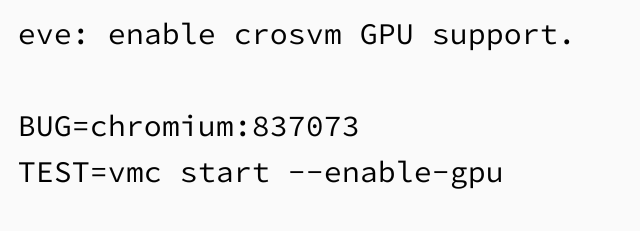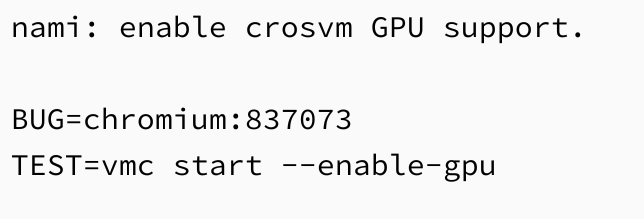I’ve been following the bug report that tracks progress on adding GPU acceleration for the Linux container in Chrome OS and there’s good news today. The first two Chrome OS boards should now, or very soon, be able to try GPU hardware acceleration with the new startup parameter found last month. The bug report says the –enable-gpu argument was added to the Eve and Nami boards:
There’s only one Eve and that’s the Pixelbook. Nami is used on a number of newer devices, including:
- Dell Inspiron 14
- Lenovo Yoga Chromebook C630
- Acer Chromebook 13
- Acer Chromebook Spin 13
- HP X360 Chromebook 14
I don’t have a Pixelbook for testing right now, otherwise, I’d pop it into Developer Mode and jump on the Canary channel. However, I do still have a loaner Acer Chromebook Spin 13, so I’ll give it a go later today and see if the newly added code from early this morning is there in the Canary Channel; if it is, I’ll circle back with observations on how well it does or doesn’t work for the Android emulator in Android Studio and possibly a game or two using Steam.
This bodes well for all Chrome OS devices that support Crostini though. There really hasn’t been a timeline for when the Chromium team would deliver on this important missing feature. I did suggest that it would arrive before or at the same time as Google officially supporting Android Studio in Crostini, mainly because developers would want the Android emulator to be functional for development. Google said that official support is coming in “early 2019”, so this code change is lining up nicely with that timeframe.




17 Comments
Yes, awesome to see this list. I am just starting to install Linux apps on my new Acer Spin 13. I’m hoping this means we can use Handbrake soon.
My guess is that this and some other tidbits are on track for I/O in May. An announcement about Android Studio support for Chrome OS.
Really glad I got this $1600 Pixel Slate device, to NOT get first access to cool new features like this. ?
Yeah, it’s a little rough. Give it a month or two and everything will come in as well. My guess is that Google just isn’t prioritising tablets for crostini, opting instead to focus on the Android side- hence why the slate got 9.0 Pie before anyone else. It’s a shame but expect faster ‘desktop’ features to come to keyboard devices first, and Android dev to Target the slates.
I’m sorry I didn’t realize my $200 keyboard accessory wasn’t a keyboard. You might even be right but if this is their thinking it’s silly. On paper Slate is the new flagship, they just have cold feet.
Coming up to three months still nothing.
No improvements to the tablet interface either.
I’m getting deja vu from the horrendous support the Pixel C received!
Seriously. Just ask the Chromebook Pixel LS 2015 users how their crostini experience is going.
Kevin, I’m afraid without nested KVM support, running a android emulator inside termina VM is going to be horrendously slow, irrespective of GPU support. I would instead Google’s announced support for AS on Chrome OS is more likely on getting another existing bug tracker issue done: for installing APKs into Arc++ without requiring Dev mode…
Still GPU support will mean possibility of getting the desktop embedding of Flutter running, which in some ways is even more interesting/exciting.
Gotta admit I’ve was a little hesitant everything into the Chromebook field, but late last year when I saw the Google Pixelbook for $700 bucks (pen was another 75), I jumped on it. Can’t believe it’s still cutting edge (I’m home) after two years of it’s release. While I like some of the new Chromebooks coming out, they still don’t match the ratios I like in the Pixelbook (weight, flexibility, power, process and appearance)
Agree…I bought one too and am loving it!!!
So did you try it on your chromebook? if it’s in the canary channel I’m gonna make the jump.
I didn’t yet because the Canary channel hasn’t been updated for the Nami devices since before I wrote this up. I’ve been checking for an update a few times a day – soon as it hits, I’ll test for sure! 🙂
Wow yeah, weirdly enough the dev channel for nami is behind the beta channel. Seems like they dont update the nami dev channel anymore. And canary is a few builds behind.
https://cros-updates-serving.appspot.com/
I think Android Emulator in Chromebooks will run in their own VM/container managed by crosvm.
I just came across a couple mentions of “Cuttlefish” on the chrome bug tracker, with the most interesting one being https://bugs.chromium.org/p/chromium/issues/detail?id=931470, to add support for multiple network interface, wifi and mobile, to crosvm.
Cuttlefish is the codename for an android device that seems currently used on Google Compute Engine.
https://github.com/google/android-cuttlefish
The Android source code for cuttlefish has also been pretty active lately: https://android.googlesource.com/device/google/cuttlefish/
Wow, thanks for the very interesting info and links!
I even wonder if cuttlefish could in future become the new anroid runtime (arc++) inside ChromeOS as its clear from the Crostini README FAQs that the ChromeOS engineers are not completely happy with the current (in)security of the Android container not being sandboxed inside a cros vm…
Yeah I thought the same thing, but didn’t want to make too many conjectures.
It could also help them run a kernel more appropriate for Android instead of relying on whatever the Chromebook comes with. They definitely need to get all the hardware acceleration working first.
Exactly. It could well be this is the Android emulator solution, but it’s not yet clear to me. But I’m digging around and reaching out to see if I can find out. ?